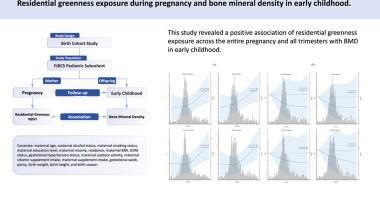怀孕期间居住环境暴露与儿童早期骨密度之间的关系。
IF 7.7
2区 环境科学与生态学
Q1 ENVIRONMENTAL SCIENCES
引用次数: 0
摘要
背景:孕期居住环境暴露对儿童早期骨密度(BMD)的影响尚不清楚。本研究旨在探讨怀孕期间住宅绿化暴露与儿童早期(0-3岁)骨密度之间的关系。方法:参与者的数据,包括人口统计学、健康状况、暴露和结局,来自福建出生队列研究中的儿科亚队列,招募时间为2019年至2021年。采用归一化植被指数(Normalized Difference Vegetation Index)对500 m缓冲范围内的绿化暴露进行量化。通过定量超声(QUS)测量骨密度,低骨密度定义为z-score低于-1。为了评估NDVI500m与骨密度和低骨密度之间的关系,应用了线性回归和逻辑回归模型。结果:产妇年龄中位数为30.50岁(IQR = 5.00)。我们发现,较高的NDVI500m暴露始终与较高的BMD z分数相关。全孕期NDVI500m IQR增加导致BMD z-评分增加0.04 (95% CI: 0.01, 0.06)。在第一、第二和第三孕期,NDVI500m暴露每增加一个IQR, BMD z-score分别增加0.03 (95% CI: 0.00, 0.06)、0.04 (95% CI: 0.00, 0.07)和0.04 (95% CI: 0.01, 0.07)。然而,NDVI500m与低BMD风险之间没有显著关系。结论:本研究揭示了在整个妊娠期和所有妊娠期暴露于住宅绿化与儿童早期骨密度呈正相关。这些发现强调了增加母亲在怀孕期间获得绿色的潜在好处,以改善后代的骨骼健康。本文章由计算机程序翻译,如有差异,请以英文原文为准。

Associations between residential greenness exposure during pregnancy and bone mineral density in early childhood
Background
The impact of residential greenness exposure during pregnancy on early childhood bone mineral density (BMD) remains poorly understood. This study aimed to examine the association between residential greenness exposure during pregnancy and BMD in early childhood (0–3 years).
Methods
Data on participants, including demographics, health status, exposures, and outcomes, were derived from the pediatric subcohort within the Fujian Birth Cohort Study, recruited from 2019 to 2021. Greenness exposure was quantified using the Normalized Difference Vegetation Index within 500-m buffer range. BMD was measured via quantitative ultrasonography (QUS), with low BMD defined as z-score below −1. To assess the associations of NDVI500m with BMD and low BMD, linear regression and logistic regression models were applied.
Results
The median maternal age was 30.50 years (IQR = 5.00). We found that higher NDVI500m exposure was consistently linked to higher BMD z-scores. An IQR increase in NDVI500m during the entire pregnancy resulted in a 0.04 (95 % CI: 0.01, 0.06) increase in BMD z-scores. For the first, second, and third trimesters, each IQR increase in NDVI500m exposure led to a 0.03 (95 % CI: 0.00, 0.06), 0.04 (95 % CI: 0.00, 0.07), and 0.04 (95 % CI: 0.01, 0.07) increase in BMD z-scores, respectively. However, no significant relationship was observed between NDVI500m and low BMD risk.
Conclusions
This study revealed a positive association of residential greenness exposure across the entire pregnancy and all trimesters with BMD in early childhood. These findings underscore the potential benefits of enhancing maternal access to greenness during pregnancy for improving offspring bone health.
求助全文
通过发布文献求助,成功后即可免费获取论文全文。
去求助
来源期刊

Environmental Research
环境科学-公共卫生、环境卫生与职业卫生
CiteScore
12.60
自引率
8.40%
发文量
2480
审稿时长
4.7 months
期刊介绍:
The Environmental Research journal presents a broad range of interdisciplinary research, focused on addressing worldwide environmental concerns and featuring innovative findings. Our publication strives to explore relevant anthropogenic issues across various environmental sectors, showcasing practical applications in real-life settings.
 求助内容:
求助内容: 应助结果提醒方式:
应助结果提醒方式:


